Healthcare Systems: Critical Analysis of the NIP in Australia, MBA621
VerifiedAdded on 2022/10/01
|11
|3236
|24
Report
AI Summary
This report provides a critical analysis of the Australian National Immunization Program (NIP), evaluating its effectiveness and impact on public health. The report begins with an executive summary outlining the program's objectives, which include enhancing national immunization coverage to minimize preventable diseases. It describes the NIP's structure, eligibility criteria, and target groups, emphasizing the program's collaborative governance involving Commonwealth, state, and territorial authorities. The analysis delves into ethical considerations, such as helping others, avoiding harm, acting fairly, and respecting individual rights. The report also addresses risk identification and management, focusing on patient safety, adherence to regulations, and the prevention of medical errors. Furthermore, it examines the existing and future policies influencing the program, as well as the legislation impacting healthcare. The quality and safety of the NIP are assessed, highlighting the program's comprehensive framework from planning to evaluation. The report concludes by acknowledging concerns raised about the program and emphasizing the importance of continuous improvement to ensure its effectiveness in safeguarding public health.
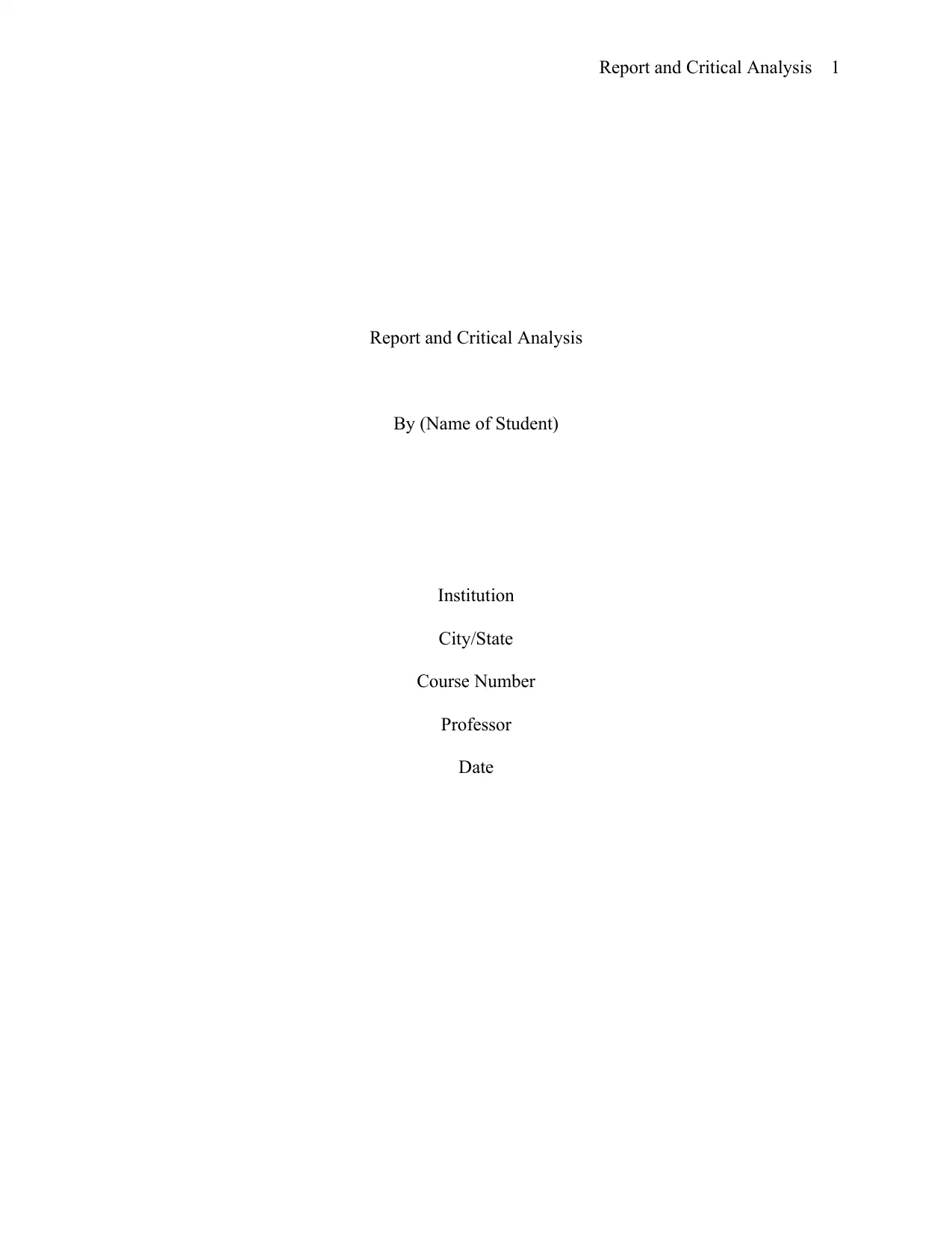
Report and Critical Analysis 1
Report and Critical Analysis
By (Name of Student)
Institution
City/State
Course Number
Professor
Date
Report and Critical Analysis
By (Name of Student)
Institution
City/State
Course Number
Professor
Date
Paraphrase This Document
Need a fresh take? Get an instant paraphrase of this document with our AI Paraphraser
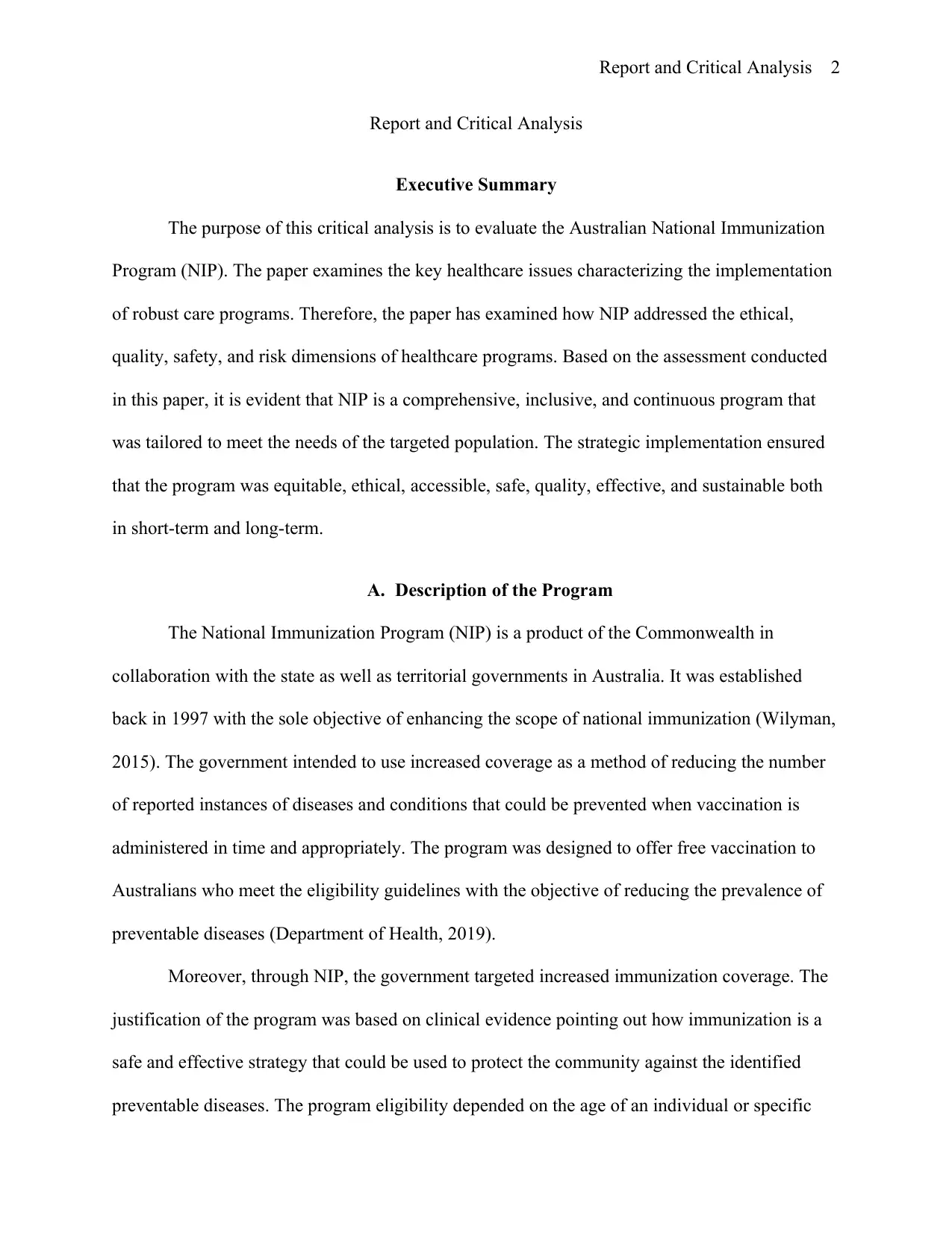
Report and Critical Analysis 2
Report and Critical Analysis
Executive Summary
The purpose of this critical analysis is to evaluate the Australian National Immunization
Program (NIP). The paper examines the key healthcare issues characterizing the implementation
of robust care programs. Therefore, the paper has examined how NIP addressed the ethical,
quality, safety, and risk dimensions of healthcare programs. Based on the assessment conducted
in this paper, it is evident that NIP is a comprehensive, inclusive, and continuous program that
was tailored to meet the needs of the targeted population. The strategic implementation ensured
that the program was equitable, ethical, accessible, safe, quality, effective, and sustainable both
in short-term and long-term.
A. Description of the Program
The National Immunization Program (NIP) is a product of the Commonwealth in
collaboration with the state as well as territorial governments in Australia. It was established
back in 1997 with the sole objective of enhancing the scope of national immunization (Wilyman,
2015). The government intended to use increased coverage as a method of reducing the number
of reported instances of diseases and conditions that could be prevented when vaccination is
administered in time and appropriately. The program was designed to offer free vaccination to
Australians who meet the eligibility guidelines with the objective of reducing the prevalence of
preventable diseases (Department of Health, 2019).
Moreover, through NIP, the government targeted increased immunization coverage. The
justification of the program was based on clinical evidence pointing out how immunization is a
safe and effective strategy that could be used to protect the community against the identified
preventable diseases. The program eligibility depended on the age of an individual or specific
Report and Critical Analysis
Executive Summary
The purpose of this critical analysis is to evaluate the Australian National Immunization
Program (NIP). The paper examines the key healthcare issues characterizing the implementation
of robust care programs. Therefore, the paper has examined how NIP addressed the ethical,
quality, safety, and risk dimensions of healthcare programs. Based on the assessment conducted
in this paper, it is evident that NIP is a comprehensive, inclusive, and continuous program that
was tailored to meet the needs of the targeted population. The strategic implementation ensured
that the program was equitable, ethical, accessible, safe, quality, effective, and sustainable both
in short-term and long-term.
A. Description of the Program
The National Immunization Program (NIP) is a product of the Commonwealth in
collaboration with the state as well as territorial governments in Australia. It was established
back in 1997 with the sole objective of enhancing the scope of national immunization (Wilyman,
2015). The government intended to use increased coverage as a method of reducing the number
of reported instances of diseases and conditions that could be prevented when vaccination is
administered in time and appropriately. The program was designed to offer free vaccination to
Australians who meet the eligibility guidelines with the objective of reducing the prevalence of
preventable diseases (Department of Health, 2019).
Moreover, through NIP, the government targeted increased immunization coverage. The
justification of the program was based on clinical evidence pointing out how immunization is a
safe and effective strategy that could be used to protect the community against the identified
preventable diseases. The program eligibility depended on the age of an individual or specific
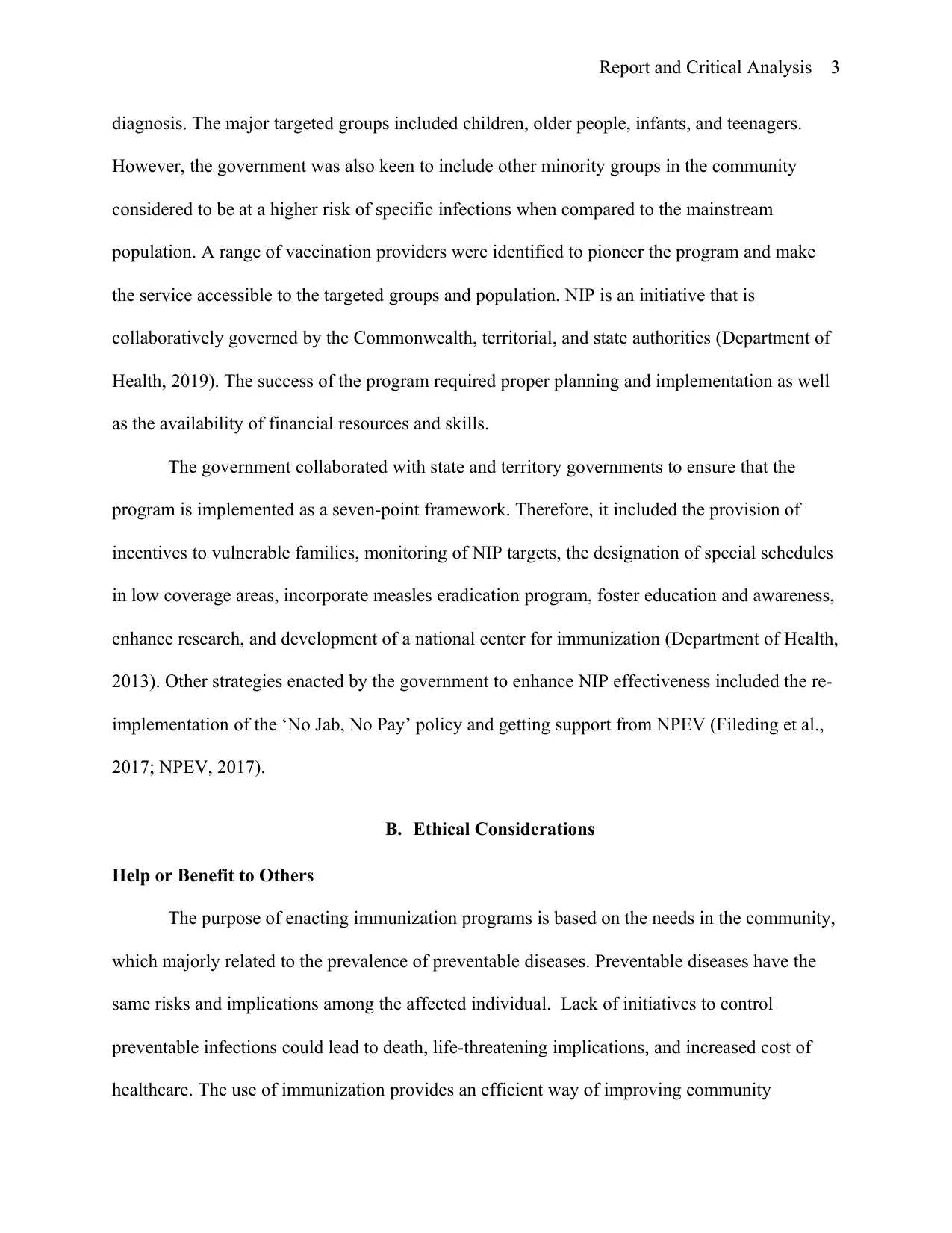
Report and Critical Analysis 3
diagnosis. The major targeted groups included children, older people, infants, and teenagers.
However, the government was also keen to include other minority groups in the community
considered to be at a higher risk of specific infections when compared to the mainstream
population. A range of vaccination providers were identified to pioneer the program and make
the service accessible to the targeted groups and population. NIP is an initiative that is
collaboratively governed by the Commonwealth, territorial, and state authorities (Department of
Health, 2019). The success of the program required proper planning and implementation as well
as the availability of financial resources and skills.
The government collaborated with state and territory governments to ensure that the
program is implemented as a seven-point framework. Therefore, it included the provision of
incentives to vulnerable families, monitoring of NIP targets, the designation of special schedules
in low coverage areas, incorporate measles eradication program, foster education and awareness,
enhance research, and development of a national center for immunization (Department of Health,
2013). Other strategies enacted by the government to enhance NIP effectiveness included the re-
implementation of the ‘No Jab, No Pay’ policy and getting support from NPEV (Fileding et al.,
2017; NPEV, 2017).
B. Ethical Considerations
Help or Benefit to Others
The purpose of enacting immunization programs is based on the needs in the community,
which majorly related to the prevalence of preventable diseases. Preventable diseases have the
same risks and implications among the affected individual. Lack of initiatives to control
preventable infections could lead to death, life-threatening implications, and increased cost of
healthcare. The use of immunization provides an efficient way of improving community
diagnosis. The major targeted groups included children, older people, infants, and teenagers.
However, the government was also keen to include other minority groups in the community
considered to be at a higher risk of specific infections when compared to the mainstream
population. A range of vaccination providers were identified to pioneer the program and make
the service accessible to the targeted groups and population. NIP is an initiative that is
collaboratively governed by the Commonwealth, territorial, and state authorities (Department of
Health, 2019). The success of the program required proper planning and implementation as well
as the availability of financial resources and skills.
The government collaborated with state and territory governments to ensure that the
program is implemented as a seven-point framework. Therefore, it included the provision of
incentives to vulnerable families, monitoring of NIP targets, the designation of special schedules
in low coverage areas, incorporate measles eradication program, foster education and awareness,
enhance research, and development of a national center for immunization (Department of Health,
2013). Other strategies enacted by the government to enhance NIP effectiveness included the re-
implementation of the ‘No Jab, No Pay’ policy and getting support from NPEV (Fileding et al.,
2017; NPEV, 2017).
B. Ethical Considerations
Help or Benefit to Others
The purpose of enacting immunization programs is based on the needs in the community,
which majorly related to the prevalence of preventable diseases. Preventable diseases have the
same risks and implications among the affected individual. Lack of initiatives to control
preventable infections could lead to death, life-threatening implications, and increased cost of
healthcare. The use of immunization provides an efficient way of improving community
⊘ This is a preview!⊘
Do you want full access?
Subscribe today to unlock all pages.

Trusted by 1+ million students worldwide
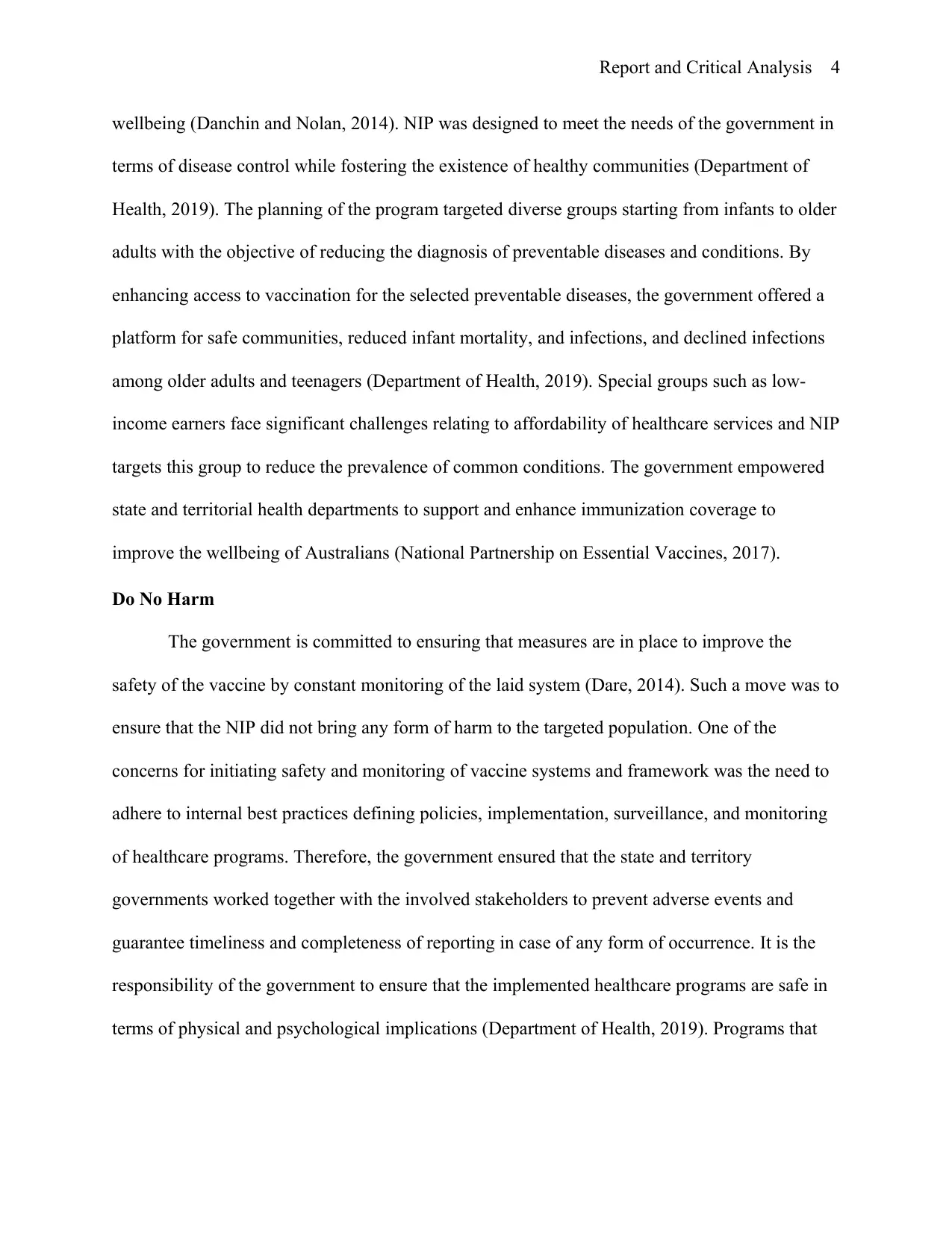
Report and Critical Analysis 4
wellbeing (Danchin and Nolan, 2014). NIP was designed to meet the needs of the government in
terms of disease control while fostering the existence of healthy communities (Department of
Health, 2019). The planning of the program targeted diverse groups starting from infants to older
adults with the objective of reducing the diagnosis of preventable diseases and conditions. By
enhancing access to vaccination for the selected preventable diseases, the government offered a
platform for safe communities, reduced infant mortality, and infections, and declined infections
among older adults and teenagers (Department of Health, 2019). Special groups such as low-
income earners face significant challenges relating to affordability of healthcare services and NIP
targets this group to reduce the prevalence of common conditions. The government empowered
state and territorial health departments to support and enhance immunization coverage to
improve the wellbeing of Australians (National Partnership on Essential Vaccines, 2017).
Do No Harm
The government is committed to ensuring that measures are in place to improve the
safety of the vaccine by constant monitoring of the laid system (Dare, 2014). Such a move was to
ensure that the NIP did not bring any form of harm to the targeted population. One of the
concerns for initiating safety and monitoring of vaccine systems and framework was the need to
adhere to internal best practices defining policies, implementation, surveillance, and monitoring
of healthcare programs. Therefore, the government ensured that the state and territory
governments worked together with the involved stakeholders to prevent adverse events and
guarantee timeliness and completeness of reporting in case of any form of occurrence. It is the
responsibility of the government to ensure that the implemented healthcare programs are safe in
terms of physical and psychological implications (Department of Health, 2019). Programs that
wellbeing (Danchin and Nolan, 2014). NIP was designed to meet the needs of the government in
terms of disease control while fostering the existence of healthy communities (Department of
Health, 2019). The planning of the program targeted diverse groups starting from infants to older
adults with the objective of reducing the diagnosis of preventable diseases and conditions. By
enhancing access to vaccination for the selected preventable diseases, the government offered a
platform for safe communities, reduced infant mortality, and infections, and declined infections
among older adults and teenagers (Department of Health, 2019). Special groups such as low-
income earners face significant challenges relating to affordability of healthcare services and NIP
targets this group to reduce the prevalence of common conditions. The government empowered
state and territorial health departments to support and enhance immunization coverage to
improve the wellbeing of Australians (National Partnership on Essential Vaccines, 2017).
Do No Harm
The government is committed to ensuring that measures are in place to improve the
safety of the vaccine by constant monitoring of the laid system (Dare, 2014). Such a move was to
ensure that the NIP did not bring any form of harm to the targeted population. One of the
concerns for initiating safety and monitoring of vaccine systems and framework was the need to
adhere to internal best practices defining policies, implementation, surveillance, and monitoring
of healthcare programs. Therefore, the government ensured that the state and territory
governments worked together with the involved stakeholders to prevent adverse events and
guarantee timeliness and completeness of reporting in case of any form of occurrence. It is the
responsibility of the government to ensure that the implemented healthcare programs are safe in
terms of physical and psychological implications (Department of Health, 2019). Programs that
Paraphrase This Document
Need a fresh take? Get an instant paraphrase of this document with our AI Paraphraser
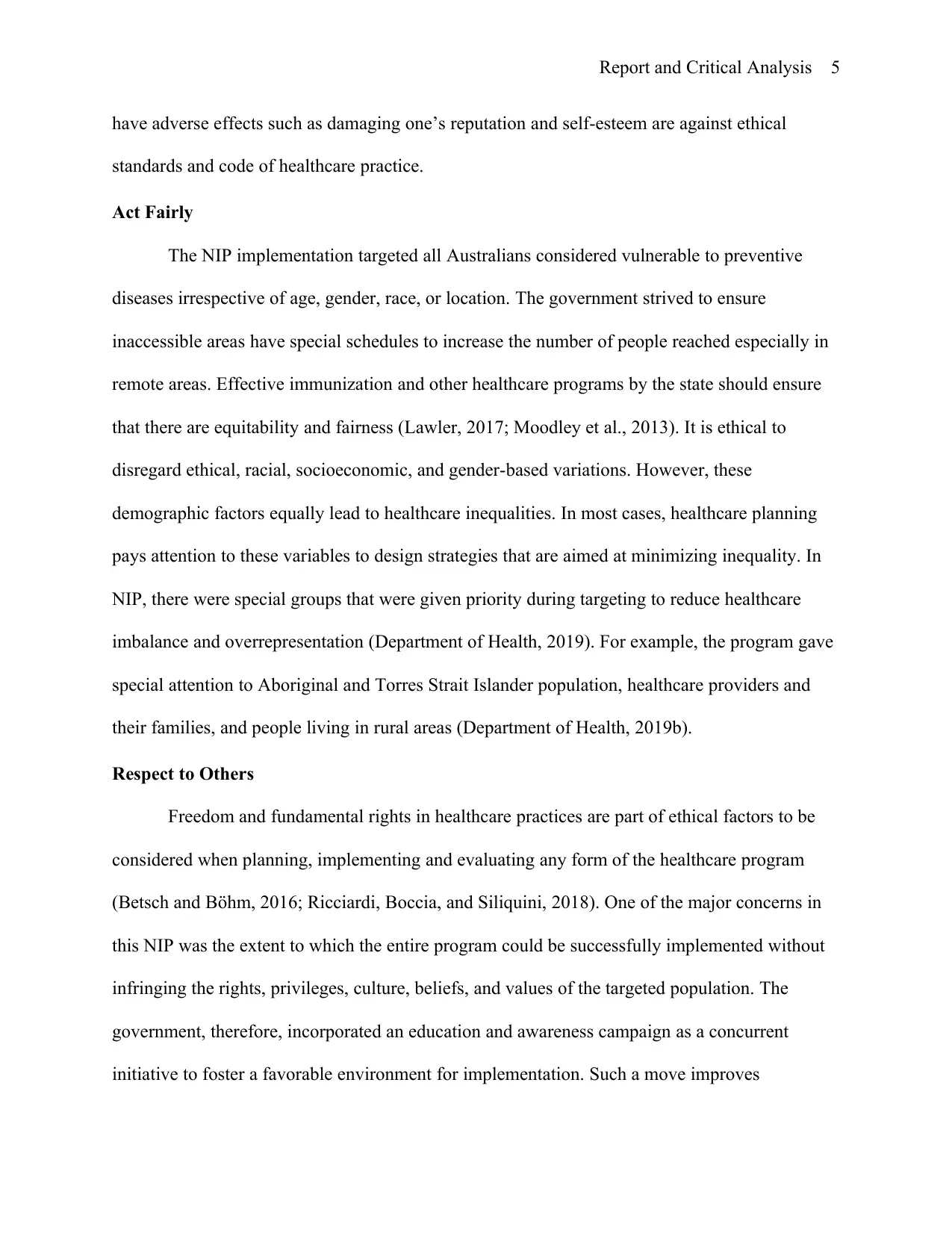
Report and Critical Analysis 5
have adverse effects such as damaging one’s reputation and self-esteem are against ethical
standards and code of healthcare practice.
Act Fairly
The NIP implementation targeted all Australians considered vulnerable to preventive
diseases irrespective of age, gender, race, or location. The government strived to ensure
inaccessible areas have special schedules to increase the number of people reached especially in
remote areas. Effective immunization and other healthcare programs by the state should ensure
that there are equitability and fairness (Lawler, 2017; Moodley et al., 2013). It is ethical to
disregard ethical, racial, socioeconomic, and gender-based variations. However, these
demographic factors equally lead to healthcare inequalities. In most cases, healthcare planning
pays attention to these variables to design strategies that are aimed at minimizing inequality. In
NIP, there were special groups that were given priority during targeting to reduce healthcare
imbalance and overrepresentation (Department of Health, 2019). For example, the program gave
special attention to Aboriginal and Torres Strait Islander population, healthcare providers and
their families, and people living in rural areas (Department of Health, 2019b).
Respect to Others
Freedom and fundamental rights in healthcare practices are part of ethical factors to be
considered when planning, implementing and evaluating any form of the healthcare program
(Betsch and Böhm, 2016; Ricciardi, Boccia, and Siliquini, 2018). One of the major concerns in
this NIP was the extent to which the entire program could be successfully implemented without
infringing the rights, privileges, culture, beliefs, and values of the targeted population. The
government, therefore, incorporated an education and awareness campaign as a concurrent
initiative to foster a favorable environment for implementation. Such a move improves
have adverse effects such as damaging one’s reputation and self-esteem are against ethical
standards and code of healthcare practice.
Act Fairly
The NIP implementation targeted all Australians considered vulnerable to preventive
diseases irrespective of age, gender, race, or location. The government strived to ensure
inaccessible areas have special schedules to increase the number of people reached especially in
remote areas. Effective immunization and other healthcare programs by the state should ensure
that there are equitability and fairness (Lawler, 2017; Moodley et al., 2013). It is ethical to
disregard ethical, racial, socioeconomic, and gender-based variations. However, these
demographic factors equally lead to healthcare inequalities. In most cases, healthcare planning
pays attention to these variables to design strategies that are aimed at minimizing inequality. In
NIP, there were special groups that were given priority during targeting to reduce healthcare
imbalance and overrepresentation (Department of Health, 2019). For example, the program gave
special attention to Aboriginal and Torres Strait Islander population, healthcare providers and
their families, and people living in rural areas (Department of Health, 2019b).
Respect to Others
Freedom and fundamental rights in healthcare practices are part of ethical factors to be
considered when planning, implementing and evaluating any form of the healthcare program
(Betsch and Böhm, 2016; Ricciardi, Boccia, and Siliquini, 2018). One of the major concerns in
this NIP was the extent to which the entire program could be successfully implemented without
infringing the rights, privileges, culture, beliefs, and values of the targeted population. The
government, therefore, incorporated an education and awareness campaign as a concurrent
initiative to foster a favorable environment for implementation. Such a move improves
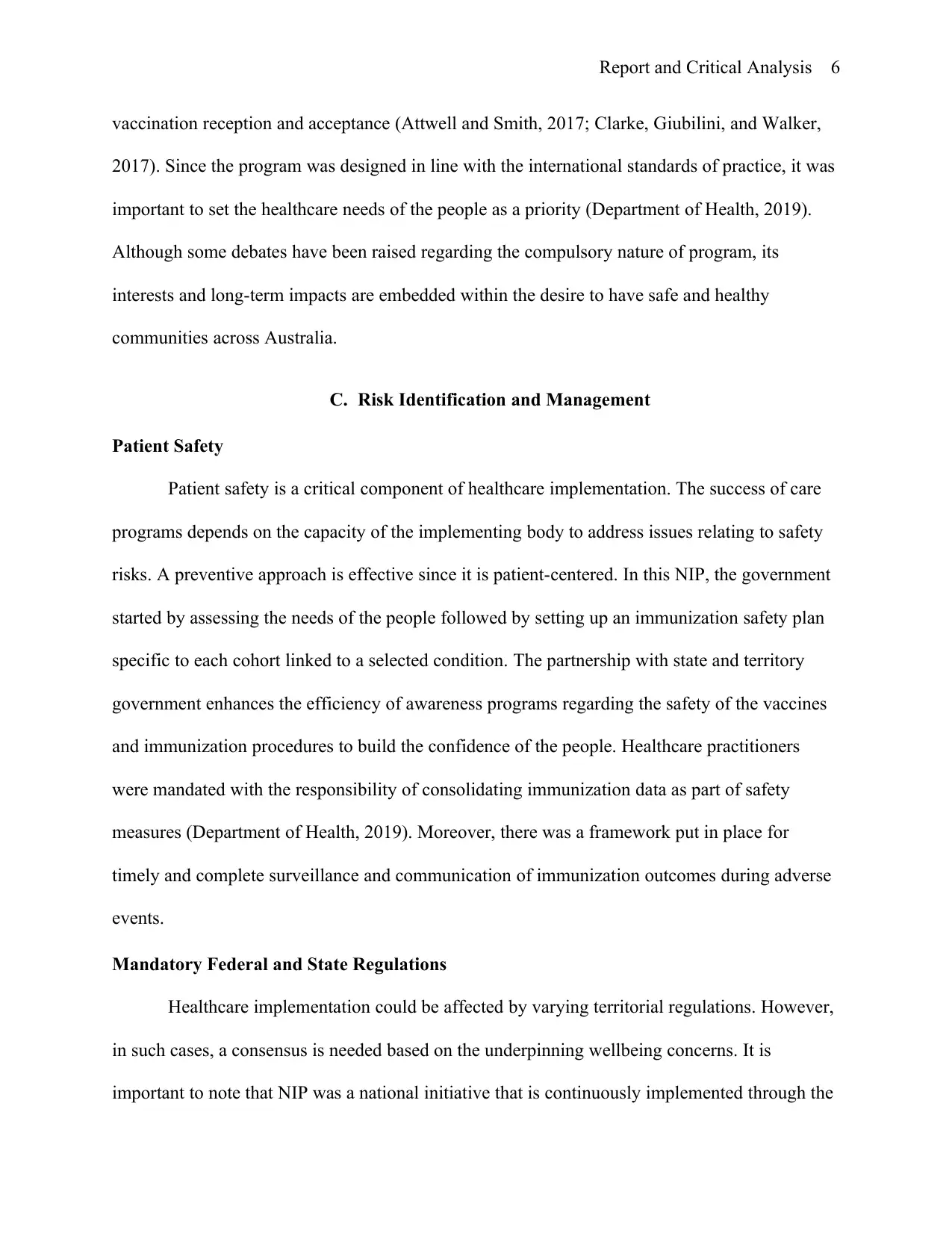
Report and Critical Analysis 6
vaccination reception and acceptance (Attwell and Smith, 2017; Clarke, Giubilini, and Walker,
2017). Since the program was designed in line with the international standards of practice, it was
important to set the healthcare needs of the people as a priority (Department of Health, 2019).
Although some debates have been raised regarding the compulsory nature of program, its
interests and long-term impacts are embedded within the desire to have safe and healthy
communities across Australia.
C. Risk Identification and Management
Patient Safety
Patient safety is a critical component of healthcare implementation. The success of care
programs depends on the capacity of the implementing body to address issues relating to safety
risks. A preventive approach is effective since it is patient-centered. In this NIP, the government
started by assessing the needs of the people followed by setting up an immunization safety plan
specific to each cohort linked to a selected condition. The partnership with state and territory
government enhances the efficiency of awareness programs regarding the safety of the vaccines
and immunization procedures to build the confidence of the people. Healthcare practitioners
were mandated with the responsibility of consolidating immunization data as part of safety
measures (Department of Health, 2019). Moreover, there was a framework put in place for
timely and complete surveillance and communication of immunization outcomes during adverse
events.
Mandatory Federal and State Regulations
Healthcare implementation could be affected by varying territorial regulations. However,
in such cases, a consensus is needed based on the underpinning wellbeing concerns. It is
important to note that NIP was a national initiative that is continuously implemented through the
vaccination reception and acceptance (Attwell and Smith, 2017; Clarke, Giubilini, and Walker,
2017). Since the program was designed in line with the international standards of practice, it was
important to set the healthcare needs of the people as a priority (Department of Health, 2019).
Although some debates have been raised regarding the compulsory nature of program, its
interests and long-term impacts are embedded within the desire to have safe and healthy
communities across Australia.
C. Risk Identification and Management
Patient Safety
Patient safety is a critical component of healthcare implementation. The success of care
programs depends on the capacity of the implementing body to address issues relating to safety
risks. A preventive approach is effective since it is patient-centered. In this NIP, the government
started by assessing the needs of the people followed by setting up an immunization safety plan
specific to each cohort linked to a selected condition. The partnership with state and territory
government enhances the efficiency of awareness programs regarding the safety of the vaccines
and immunization procedures to build the confidence of the people. Healthcare practitioners
were mandated with the responsibility of consolidating immunization data as part of safety
measures (Department of Health, 2019). Moreover, there was a framework put in place for
timely and complete surveillance and communication of immunization outcomes during adverse
events.
Mandatory Federal and State Regulations
Healthcare implementation could be affected by varying territorial regulations. However,
in such cases, a consensus is needed based on the underpinning wellbeing concerns. It is
important to note that NIP was a national initiative that is continuously implemented through the
⊘ This is a preview!⊘
Do you want full access?
Subscribe today to unlock all pages.

Trusted by 1+ million students worldwide
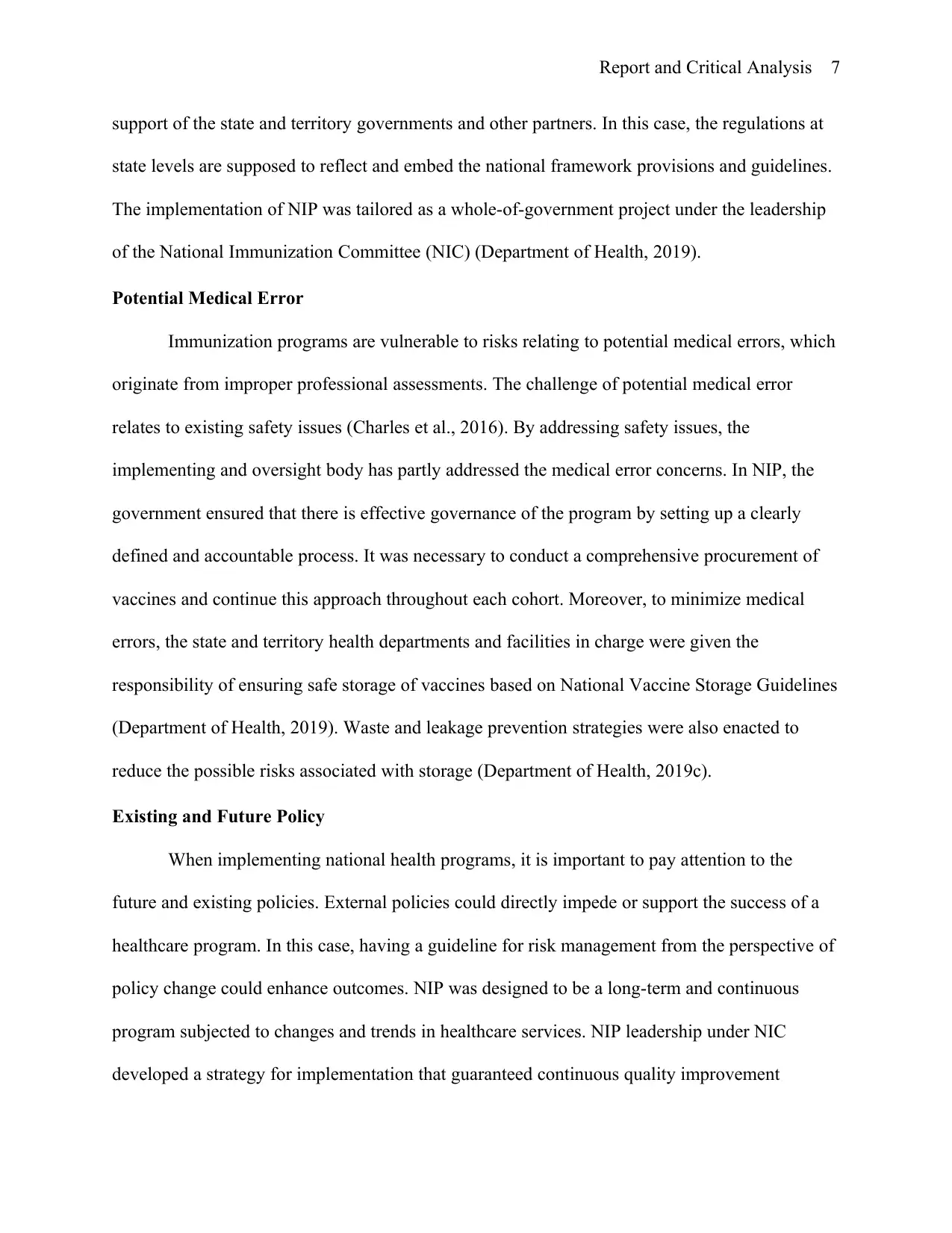
Report and Critical Analysis 7
support of the state and territory governments and other partners. In this case, the regulations at
state levels are supposed to reflect and embed the national framework provisions and guidelines.
The implementation of NIP was tailored as a whole-of-government project under the leadership
of the National Immunization Committee (NIC) (Department of Health, 2019).
Potential Medical Error
Immunization programs are vulnerable to risks relating to potential medical errors, which
originate from improper professional assessments. The challenge of potential medical error
relates to existing safety issues (Charles et al., 2016). By addressing safety issues, the
implementing and oversight body has partly addressed the medical error concerns. In NIP, the
government ensured that there is effective governance of the program by setting up a clearly
defined and accountable process. It was necessary to conduct a comprehensive procurement of
vaccines and continue this approach throughout each cohort. Moreover, to minimize medical
errors, the state and territory health departments and facilities in charge were given the
responsibility of ensuring safe storage of vaccines based on National Vaccine Storage Guidelines
(Department of Health, 2019). Waste and leakage prevention strategies were also enacted to
reduce the possible risks associated with storage (Department of Health, 2019c).
Existing and Future Policy
When implementing national health programs, it is important to pay attention to the
future and existing policies. External policies could directly impede or support the success of a
healthcare program. In this case, having a guideline for risk management from the perspective of
policy change could enhance outcomes. NIP was designed to be a long-term and continuous
program subjected to changes and trends in healthcare services. NIP leadership under NIC
developed a strategy for implementation that guaranteed continuous quality improvement
support of the state and territory governments and other partners. In this case, the regulations at
state levels are supposed to reflect and embed the national framework provisions and guidelines.
The implementation of NIP was tailored as a whole-of-government project under the leadership
of the National Immunization Committee (NIC) (Department of Health, 2019).
Potential Medical Error
Immunization programs are vulnerable to risks relating to potential medical errors, which
originate from improper professional assessments. The challenge of potential medical error
relates to existing safety issues (Charles et al., 2016). By addressing safety issues, the
implementing and oversight body has partly addressed the medical error concerns. In NIP, the
government ensured that there is effective governance of the program by setting up a clearly
defined and accountable process. It was necessary to conduct a comprehensive procurement of
vaccines and continue this approach throughout each cohort. Moreover, to minimize medical
errors, the state and territory health departments and facilities in charge were given the
responsibility of ensuring safe storage of vaccines based on National Vaccine Storage Guidelines
(Department of Health, 2019). Waste and leakage prevention strategies were also enacted to
reduce the possible risks associated with storage (Department of Health, 2019c).
Existing and Future Policy
When implementing national health programs, it is important to pay attention to the
future and existing policies. External policies could directly impede or support the success of a
healthcare program. In this case, having a guideline for risk management from the perspective of
policy change could enhance outcomes. NIP was designed to be a long-term and continuous
program subjected to changes and trends in healthcare services. NIP leadership under NIC
developed a strategy for implementation that guaranteed continuous quality improvement
Paraphrase This Document
Need a fresh take? Get an instant paraphrase of this document with our AI Paraphraser
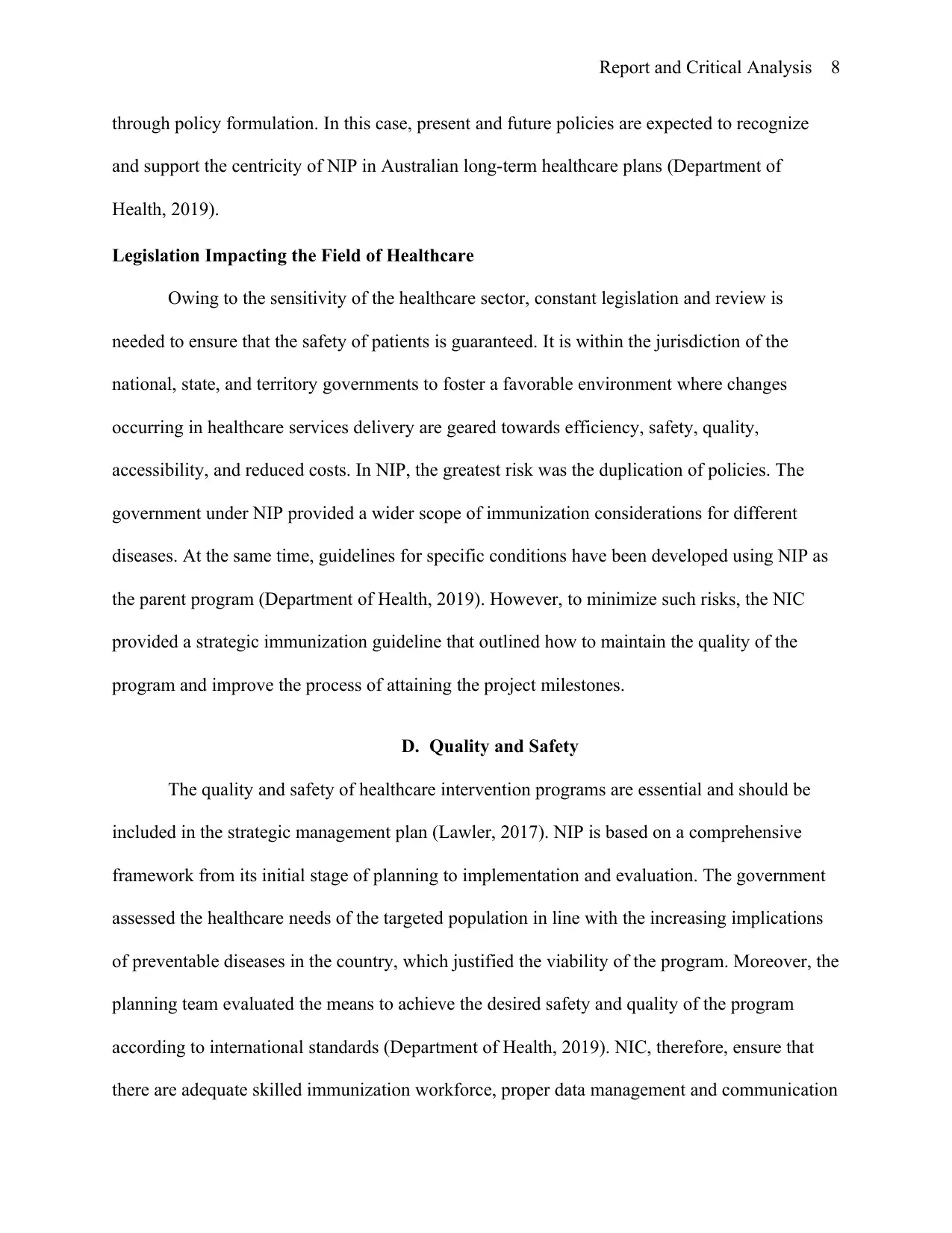
Report and Critical Analysis 8
through policy formulation. In this case, present and future policies are expected to recognize
and support the centricity of NIP in Australian long-term healthcare plans (Department of
Health, 2019).
Legislation Impacting the Field of Healthcare
Owing to the sensitivity of the healthcare sector, constant legislation and review is
needed to ensure that the safety of patients is guaranteed. It is within the jurisdiction of the
national, state, and territory governments to foster a favorable environment where changes
occurring in healthcare services delivery are geared towards efficiency, safety, quality,
accessibility, and reduced costs. In NIP, the greatest risk was the duplication of policies. The
government under NIP provided a wider scope of immunization considerations for different
diseases. At the same time, guidelines for specific conditions have been developed using NIP as
the parent program (Department of Health, 2019). However, to minimize such risks, the NIC
provided a strategic immunization guideline that outlined how to maintain the quality of the
program and improve the process of attaining the project milestones.
D. Quality and Safety
The quality and safety of healthcare intervention programs are essential and should be
included in the strategic management plan (Lawler, 2017). NIP is based on a comprehensive
framework from its initial stage of planning to implementation and evaluation. The government
assessed the healthcare needs of the targeted population in line with the increasing implications
of preventable diseases in the country, which justified the viability of the program. Moreover, the
planning team evaluated the means to achieve the desired safety and quality of the program
according to international standards (Department of Health, 2019). NIC, therefore, ensure that
there are adequate skilled immunization workforce, proper data management and communication
through policy formulation. In this case, present and future policies are expected to recognize
and support the centricity of NIP in Australian long-term healthcare plans (Department of
Health, 2019).
Legislation Impacting the Field of Healthcare
Owing to the sensitivity of the healthcare sector, constant legislation and review is
needed to ensure that the safety of patients is guaranteed. It is within the jurisdiction of the
national, state, and territory governments to foster a favorable environment where changes
occurring in healthcare services delivery are geared towards efficiency, safety, quality,
accessibility, and reduced costs. In NIP, the greatest risk was the duplication of policies. The
government under NIP provided a wider scope of immunization considerations for different
diseases. At the same time, guidelines for specific conditions have been developed using NIP as
the parent program (Department of Health, 2019). However, to minimize such risks, the NIC
provided a strategic immunization guideline that outlined how to maintain the quality of the
program and improve the process of attaining the project milestones.
D. Quality and Safety
The quality and safety of healthcare intervention programs are essential and should be
included in the strategic management plan (Lawler, 2017). NIP is based on a comprehensive
framework from its initial stage of planning to implementation and evaluation. The government
assessed the healthcare needs of the targeted population in line with the increasing implications
of preventable diseases in the country, which justified the viability of the program. Moreover, the
planning team evaluated the means to achieve the desired safety and quality of the program
according to international standards (Department of Health, 2019). NIC, therefore, ensure that
there are adequate skilled immunization workforce, proper data management and communication
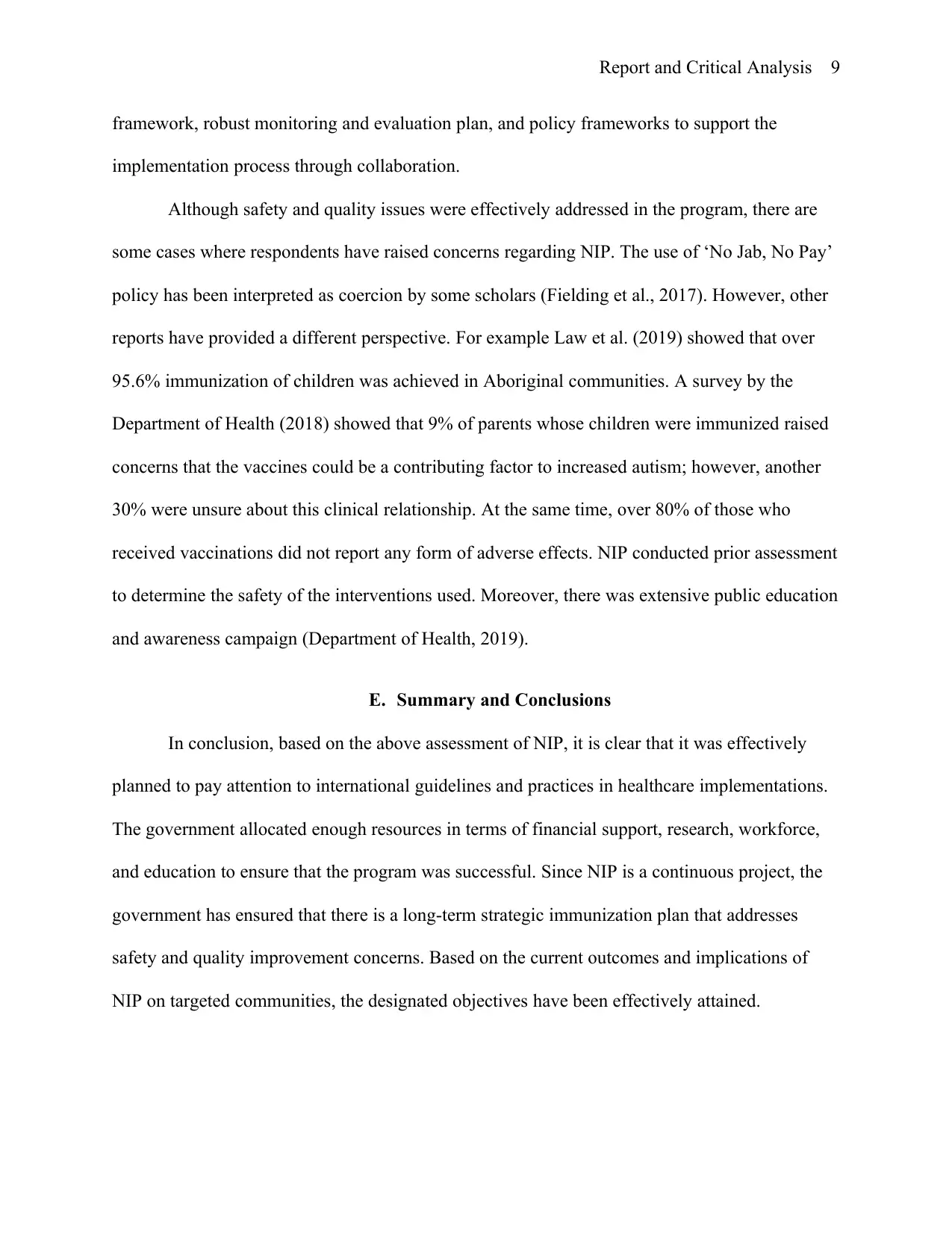
Report and Critical Analysis 9
framework, robust monitoring and evaluation plan, and policy frameworks to support the
implementation process through collaboration.
Although safety and quality issues were effectively addressed in the program, there are
some cases where respondents have raised concerns regarding NIP. The use of ‘No Jab, No Pay’
policy has been interpreted as coercion by some scholars (Fielding et al., 2017). However, other
reports have provided a different perspective. For example Law et al. (2019) showed that over
95.6% immunization of children was achieved in Aboriginal communities. A survey by the
Department of Health (2018) showed that 9% of parents whose children were immunized raised
concerns that the vaccines could be a contributing factor to increased autism; however, another
30% were unsure about this clinical relationship. At the same time, over 80% of those who
received vaccinations did not report any form of adverse effects. NIP conducted prior assessment
to determine the safety of the interventions used. Moreover, there was extensive public education
and awareness campaign (Department of Health, 2019).
E. Summary and Conclusions
In conclusion, based on the above assessment of NIP, it is clear that it was effectively
planned to pay attention to international guidelines and practices in healthcare implementations.
The government allocated enough resources in terms of financial support, research, workforce,
and education to ensure that the program was successful. Since NIP is a continuous project, the
government has ensured that there is a long-term strategic immunization plan that addresses
safety and quality improvement concerns. Based on the current outcomes and implications of
NIP on targeted communities, the designated objectives have been effectively attained.
framework, robust monitoring and evaluation plan, and policy frameworks to support the
implementation process through collaboration.
Although safety and quality issues were effectively addressed in the program, there are
some cases where respondents have raised concerns regarding NIP. The use of ‘No Jab, No Pay’
policy has been interpreted as coercion by some scholars (Fielding et al., 2017). However, other
reports have provided a different perspective. For example Law et al. (2019) showed that over
95.6% immunization of children was achieved in Aboriginal communities. A survey by the
Department of Health (2018) showed that 9% of parents whose children were immunized raised
concerns that the vaccines could be a contributing factor to increased autism; however, another
30% were unsure about this clinical relationship. At the same time, over 80% of those who
received vaccinations did not report any form of adverse effects. NIP conducted prior assessment
to determine the safety of the interventions used. Moreover, there was extensive public education
and awareness campaign (Department of Health, 2019).
E. Summary and Conclusions
In conclusion, based on the above assessment of NIP, it is clear that it was effectively
planned to pay attention to international guidelines and practices in healthcare implementations.
The government allocated enough resources in terms of financial support, research, workforce,
and education to ensure that the program was successful. Since NIP is a continuous project, the
government has ensured that there is a long-term strategic immunization plan that addresses
safety and quality improvement concerns. Based on the current outcomes and implications of
NIP on targeted communities, the designated objectives have been effectively attained.
⊘ This is a preview!⊘
Do you want full access?
Subscribe today to unlock all pages.

Trusted by 1+ million students worldwide
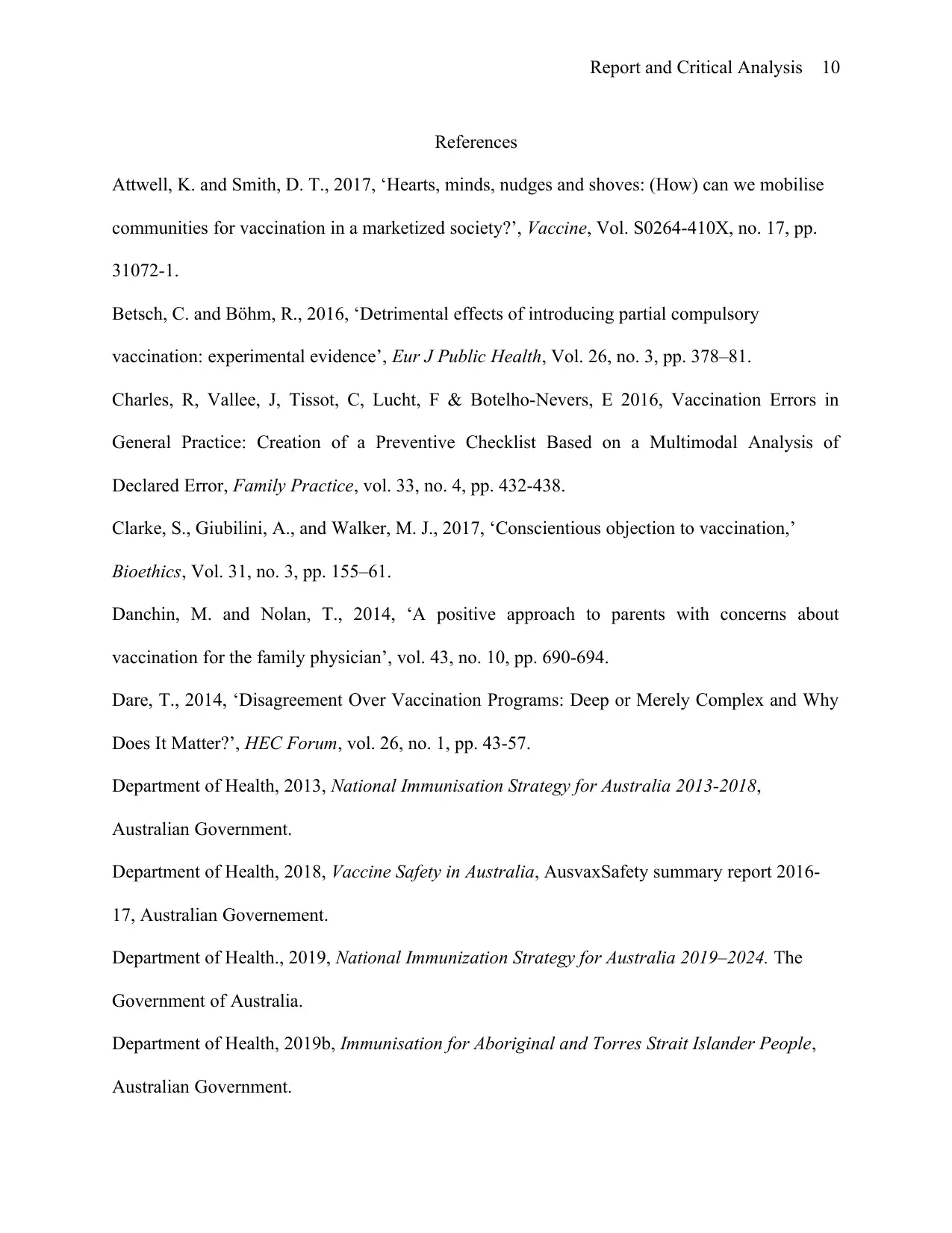
Report and Critical Analysis 10
References
Attwell, K. and Smith, D. T., 2017, ‘Hearts, minds, nudges and shoves: (How) can we mobilise
communities for vaccination in a marketized society?’, Vaccine, Vol. S0264-410X, no. 17, pp.
31072-1.
Betsch, C. and Böhm, R., 2016, ‘Detrimental effects of introducing partial compulsory
vaccination: experimental evidence’, Eur J Public Health, Vol. 26, no. 3, pp. 378–81.
Charles, R, Vallee, J, Tissot, C, Lucht, F & Botelho-Nevers, E 2016, Vaccination Errors in
General Practice: Creation of a Preventive Checklist Based on a Multimodal Analysis of
Declared Error, Family Practice, vol. 33, no. 4, pp. 432-438.
Clarke, S., Giubilini, A., and Walker, M. J., 2017, ‘Conscientious objection to vaccination,’
Bioethics, Vol. 31, no. 3, pp. 155–61.
Danchin, M. and Nolan, T., 2014, ‘A positive approach to parents with concerns about
vaccination for the family physician’, vol. 43, no. 10, pp. 690-694.
Dare, T., 2014, ‘Disagreement Over Vaccination Programs: Deep or Merely Complex and Why
Does It Matter?’, HEC Forum, vol. 26, no. 1, pp. 43-57.
Department of Health, 2013, National Immunisation Strategy for Australia 2013-2018,
Australian Government.
Department of Health, 2018, Vaccine Safety in Australia, AusvaxSafety summary report 2016-
17, Australian Governement.
Department of Health., 2019, National Immunization Strategy for Australia 2019–2024. The
Government of Australia.
Department of Health, 2019b, Immunisation for Aboriginal and Torres Strait Islander People,
Australian Government.
References
Attwell, K. and Smith, D. T., 2017, ‘Hearts, minds, nudges and shoves: (How) can we mobilise
communities for vaccination in a marketized society?’, Vaccine, Vol. S0264-410X, no. 17, pp.
31072-1.
Betsch, C. and Böhm, R., 2016, ‘Detrimental effects of introducing partial compulsory
vaccination: experimental evidence’, Eur J Public Health, Vol. 26, no. 3, pp. 378–81.
Charles, R, Vallee, J, Tissot, C, Lucht, F & Botelho-Nevers, E 2016, Vaccination Errors in
General Practice: Creation of a Preventive Checklist Based on a Multimodal Analysis of
Declared Error, Family Practice, vol. 33, no. 4, pp. 432-438.
Clarke, S., Giubilini, A., and Walker, M. J., 2017, ‘Conscientious objection to vaccination,’
Bioethics, Vol. 31, no. 3, pp. 155–61.
Danchin, M. and Nolan, T., 2014, ‘A positive approach to parents with concerns about
vaccination for the family physician’, vol. 43, no. 10, pp. 690-694.
Dare, T., 2014, ‘Disagreement Over Vaccination Programs: Deep or Merely Complex and Why
Does It Matter?’, HEC Forum, vol. 26, no. 1, pp. 43-57.
Department of Health, 2013, National Immunisation Strategy for Australia 2013-2018,
Australian Government.
Department of Health, 2018, Vaccine Safety in Australia, AusvaxSafety summary report 2016-
17, Australian Governement.
Department of Health., 2019, National Immunization Strategy for Australia 2019–2024. The
Government of Australia.
Department of Health, 2019b, Immunisation for Aboriginal and Torres Strait Islander People,
Australian Government.
Paraphrase This Document
Need a fresh take? Get an instant paraphrase of this document with our AI Paraphraser
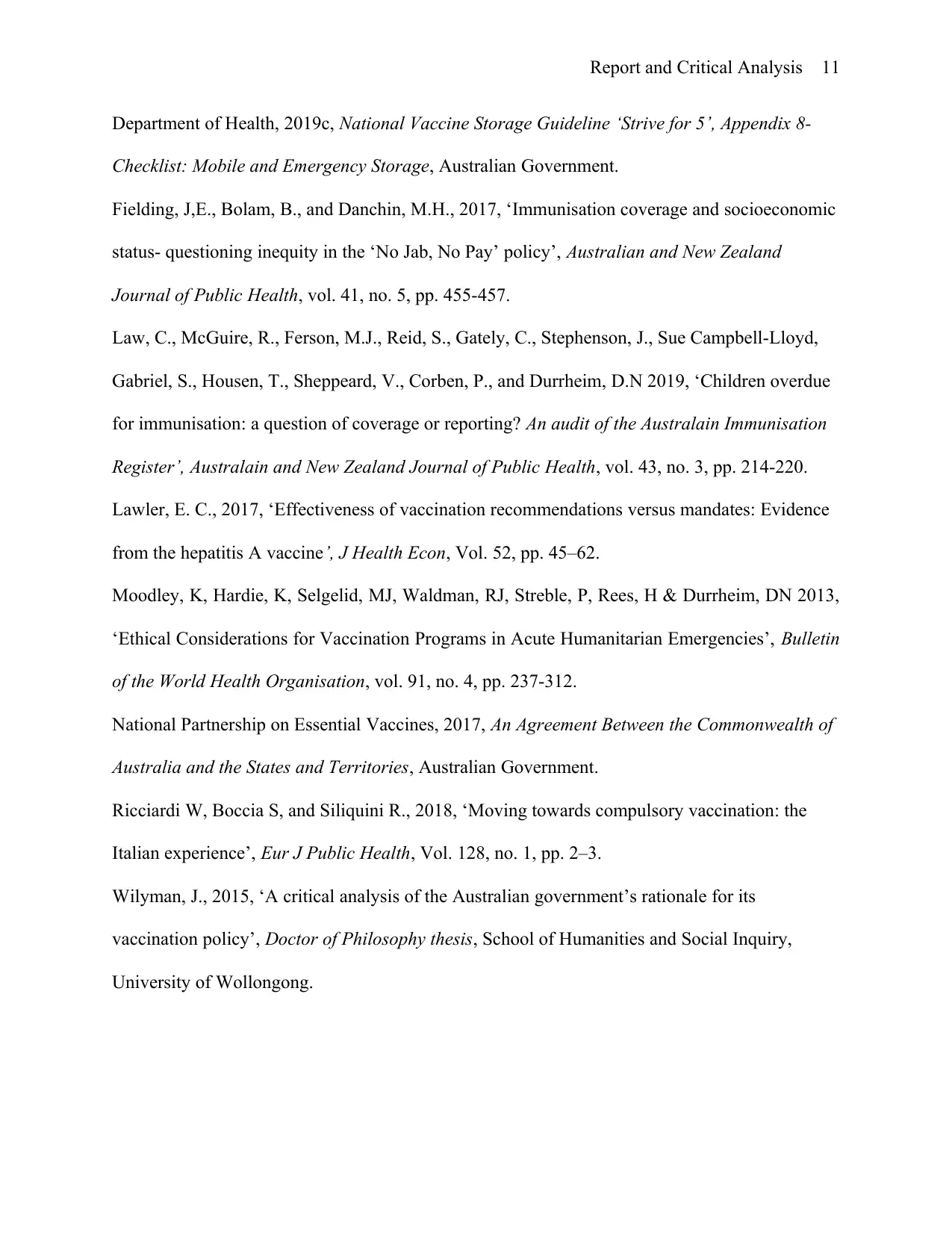
Report and Critical Analysis 11
Department of Health, 2019c, National Vaccine Storage Guideline ‘Strive for 5’, Appendix 8-
Checklist: Mobile and Emergency Storage, Australian Government.
Fielding, J,E., Bolam, B., and Danchin, M.H., 2017, ‘Immunisation coverage and socioeconomic
status- questioning inequity in the ‘No Jab, No Pay’ policy’, Australian and New Zealand
Journal of Public Health, vol. 41, no. 5, pp. 455-457.
Law, C., McGuire, R., Ferson, M.J., Reid, S., Gately, C., Stephenson, J., Sue Campbell-Lloyd,
Gabriel, S., Housen, T., Sheppeard, V., Corben, P., and Durrheim, D.N 2019, ‘Children overdue
for immunisation: a question of coverage or reporting? An audit of the Australain Immunisation
Register’, Australain and New Zealand Journal of Public Health, vol. 43, no. 3, pp. 214-220.
Lawler, E. C., 2017, ‘Effectiveness of vaccination recommendations versus mandates: Evidence
from the hepatitis A vaccine’, J Health Econ, Vol. 52, pp. 45–62.
Moodley, K, Hardie, K, Selgelid, MJ, Waldman, RJ, Streble, P, Rees, H & Durrheim, DN 2013,
‘Ethical Considerations for Vaccination Programs in Acute Humanitarian Emergencies’, Bulletin
of the World Health Organisation, vol. 91, no. 4, pp. 237-312.
National Partnership on Essential Vaccines, 2017, An Agreement Between the Commonwealth of
Australia and the States and Territories, Australian Government.
Ricciardi W, Boccia S, and Siliquini R., 2018, ‘Moving towards compulsory vaccination: the
Italian experience’, Eur J Public Health, Vol. 128, no. 1, pp. 2–3.
Wilyman, J., 2015, ‘A critical analysis of the Australian government’s rationale for its
vaccination policy’, Doctor of Philosophy thesis, School of Humanities and Social Inquiry,
University of Wollongong.
Department of Health, 2019c, National Vaccine Storage Guideline ‘Strive for 5’, Appendix 8-
Checklist: Mobile and Emergency Storage, Australian Government.
Fielding, J,E., Bolam, B., and Danchin, M.H., 2017, ‘Immunisation coverage and socioeconomic
status- questioning inequity in the ‘No Jab, No Pay’ policy’, Australian and New Zealand
Journal of Public Health, vol. 41, no. 5, pp. 455-457.
Law, C., McGuire, R., Ferson, M.J., Reid, S., Gately, C., Stephenson, J., Sue Campbell-Lloyd,
Gabriel, S., Housen, T., Sheppeard, V., Corben, P., and Durrheim, D.N 2019, ‘Children overdue
for immunisation: a question of coverage or reporting? An audit of the Australain Immunisation
Register’, Australain and New Zealand Journal of Public Health, vol. 43, no. 3, pp. 214-220.
Lawler, E. C., 2017, ‘Effectiveness of vaccination recommendations versus mandates: Evidence
from the hepatitis A vaccine’, J Health Econ, Vol. 52, pp. 45–62.
Moodley, K, Hardie, K, Selgelid, MJ, Waldman, RJ, Streble, P, Rees, H & Durrheim, DN 2013,
‘Ethical Considerations for Vaccination Programs in Acute Humanitarian Emergencies’, Bulletin
of the World Health Organisation, vol. 91, no. 4, pp. 237-312.
National Partnership on Essential Vaccines, 2017, An Agreement Between the Commonwealth of
Australia and the States and Territories, Australian Government.
Ricciardi W, Boccia S, and Siliquini R., 2018, ‘Moving towards compulsory vaccination: the
Italian experience’, Eur J Public Health, Vol. 128, no. 1, pp. 2–3.
Wilyman, J., 2015, ‘A critical analysis of the Australian government’s rationale for its
vaccination policy’, Doctor of Philosophy thesis, School of Humanities and Social Inquiry,
University of Wollongong.
1 out of 11
Related Documents
Your All-in-One AI-Powered Toolkit for Academic Success.
+13062052269
info@desklib.com
Available 24*7 on WhatsApp / Email
![[object Object]](/_next/static/media/star-bottom.7253800d.svg)
Unlock your academic potential
Copyright © 2020–2025 A2Z Services. All Rights Reserved. Developed and managed by ZUCOL.





